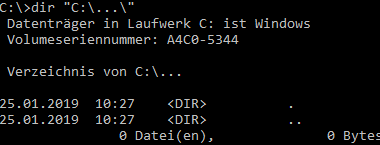Solved this by my co worker, sadly I closed the cmd before realizing it.. I'll write the things I remember..
My CoWorker got the "..." directory in root of C: So I tried these:
dir "C:\...\"
And a empty directory was shown. So a
rmdir "C:\...\"
deletes the directory
A bit Background:
Windows File-IO APIs call at first a file name check. And a "..." was interpenetrated as ".." - so, go a director up. Try thyping in Exporer "C:\Windows..\ProgramData". (FYI: In the API is mentioned: If the filename beginns with "\?\", the check is disabled and Such directories can be accessed: Because it turns off automatic expansion of the path string, the "\\?\" prefix also allows the use of ".." and "." in the path names, which can be useful if you are attempting to perform operations on a file with these otherwise reserved relative path specifiers as part of the fully qualified path. But this is information for a programmer.)
Edit:
Because of the discussion "Fit this answer to the question?":
I've tested it. Created a directory. This is how it looks like in Explorer:

And this is what you see with "dir":

So: The directory is empty, but Explorer is showing "wrong" information. This is not a conflict considering how the Windows API works: The File API tries to do interpretation of the file / directory name. So move a directory up, if there is a "..", etc. That is what you see in the explorer view. In the cmd I tried to find a string forcing the Windows API no doing a interpretation.




Can your rename the folder by selecting it, press
F2and then alter its name? – LPChip – 2015-12-08T11:05:10.120@lpchip No can't rename it, at least while files in the sub folders are in use (closing the files would mean to log off all users from the terminal servers which we would like to avoid) – marsh-wiggle – 2015-12-08T11:15:16.750
If you can't rename because files are in use, you won't be able to do anything with the files really. – LPChip – 2015-12-08T11:35:23.337
What does
dir /al(not/ah) show? – dxiv – 2015-12-08T19:10:08.447@divx "no files found" for
dir /al&dir /ahl– marsh-wiggle – 2015-12-09T07:23:41.573